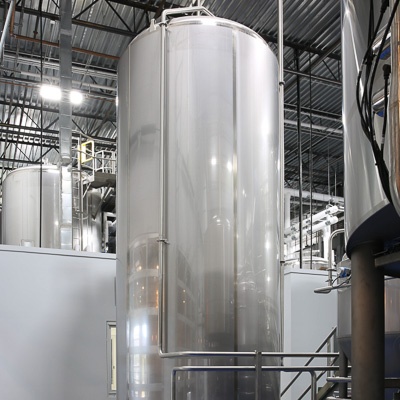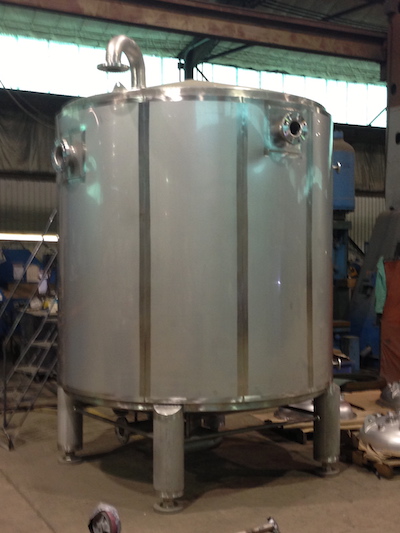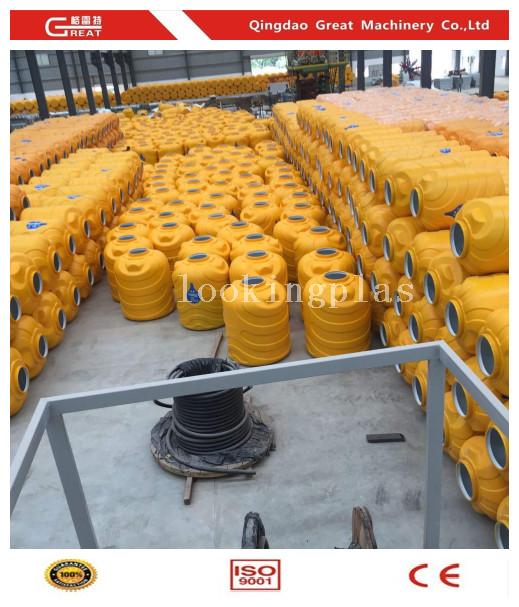Top Developments in Storage Tank Manufacturing: Enhancing Performance and Sustainability
The landscape of storage tank manufacturing is undertaking substantial transformation as sector leaders increasingly adopt technologies aimed at improving both effectiveness and sustainability. Secret developments, including the usage of sophisticated materials and clever innovations, are redefining functional standards while resolving ecological problems. Furthermore, modular container styles and green manufacturing processes existing new opportunities for resource optimization. As these fads remain to develop, the effects for industry techniques and long-lasting sustainability goals benefit additionally exploration. What specific technologies are establishing the phase for this paradigm change?
Advanced Materials for Sturdiness
The evolution of storage tank manufacturing is increasingly driven by the combination of advanced materials created to boost durability and performance. Generally, tank were built mainly from carbon steel, which, while reliable, is prone to corrosion and structural deterioration with time. Texas Oil & Gas Storage Tank Fabrication Authority. Current advancements have seen the intro of high-performance alloys, composite products, and polymers that provide remarkable resistance to ecological factors and chemical direct exposure
For circumstances, stainless-steel and duplex alloys are now common in applications requiring increased deterioration resistance, specifically in chemical or marine storage space environments. In addition, composite materials, such as fiberglass-reinforced plastics, offer a superb strength-to-weight ratio while lessening maintenance prices due to their non-corrosive nature. These technologies not just expand the lifespan of storage containers however likewise enhance their operational efficiency.
Furthermore, the fostering of nanotechnology in coverings is confirming beneficial in further enhancing the safety residential properties of storage tank surface areas. These developments not just minimize the frequency of assessments and repairs but also contribute to sustainability by reducing source consumption and waste. As the industry proceeds to introduce, the focus on advanced materials will certainly stay a foundation of storage tank manufacturing, making certain safety and reliability popular applications.
Smart Checking Technologies
Advancements in wise surveillance technologies are transforming the management and upkeep of storage tanks (Fox Tank Company Permian Basin). These innovations utilize the Web of Points (IoT), expert system (AI), and advanced sensing unit modern technologies to improve functional performance and security. By incorporating real-time information collection, drivers can monitor storage tank problems, such as temperature level, stress, and fluid degrees, with unprecedented accuracy
Smart monitoring systems enable predictive upkeep, permitting prompt interventions prior to prospective failures occur. This minimizes downtime and reduces upkeep costs, as operators can address issues based upon data-driven understandings as opposed to responsive procedures. Additionally, these modern technologies improve safety protocols by giving informs for leakages, overfills, or structural weaknesses, greatly alleviating environmental threats.
Cloud-based platforms assist in central monitoring throughout several places, enabling operators to make informed decisions promptly. Enhanced data analytics likewise add to enhancing inventory management, ensuring that sources are used effectively.
As regulative needs for ecological compliance become increasingly rigorous, clever tracking modern technologies play an important role in making sure tank fulfill these criteria. Overall, the fostering of these innovations not just enhances operational effectiveness however additionally promotes sustainability in storage tank manufacturing and monitoring.
Modular Tank Styles
Modular tank layouts are reinventing the storage tank industry by providing improved customization alternatives that cater to details customer needs. These designs not only promote customized remedies but additionally provide space-saving configurations, making them perfect for varied atmospheres. As industries look for effectiveness and adaptability, modular tanks offer an engaging option to typical storage space remedies.
Improved Modification Options
As makers seek to fulfill varied client demands, improved customization choices in storage tank style have actually come to be progressively common. Modular tank designs exhibit this pattern, enabling customized setups that accommodate different functional needs. By utilizing modular elements, suppliers can develop containers of various dimensions, shapes, and functionalities, making certain compatibility with certain applications.
These personalized storage tanks can be adjusted to hold different kinds of fluids, including hazardous materials, without endangering security or effectiveness. Furthermore, modular designs assist in scalability, enabling business to increase their storage capability effortlessly as need expands. This versatility not only optimizes room usage however additionally decreases the total lifecycle expenses connected with storage tank installment and upkeep.
Furthermore, enhanced customization options include innovative attributes such as incorporated monitoring systems, insulation, and specialized coatings that improve sturdiness and performance. By providing an array of choices, suppliers empower clients to choose designs that straighten with their functional goals and sustainability campaigns.
Ultimately, the surge of improved modification options in storage tank manufacturing highlights a dedication to technology, allowing markets to react efficiently to advancing market needs while enhancing overall performance and environmental stewardship. (Permian Basin Oil & Water Tank Company)
Space-Saving Setups
Taking full advantage of space effectiveness has come to be a vital factor to consider in storage tank style, particularly with the introduction of modular storage tank arrangements. These cutting-edge layouts enable the setting up of containers in numerous plans, providing versatility and flexibility in space-constrained settings. Modular containers can be conveniently moved and set up, making them perfect for markets calling for on-site storage solutions.
The use of modular designs not only maximizes space however also boosts scalability. Organizations can begin with a smaller sized unit and broaden their storage space capability by adding additional components as need boosts. This incremental method lowers upfront costs and allows for far better source monitoring. Modular containers can be personalized relating to arrangement, dimension, and material, catering to details operational needs.
Sustainability is additionally an essential benefit of modular container setups. By using standard components, producers can lower waste during manufacturing and enhance the supply chain. Additionally, these storage tanks frequently feature boosted insulation and energy-efficient designs, causing lower functional costs.
Eco-Friendly Manufacturing Processes
As the need for environmentally accountable manufacturing expands, the storage tank market is accepting environmentally friendly procedures to boost sustainability. This includes the choice of sustainable materials, the application of energy-efficient production strategies, and the adoption of waste decrease techniques. By focusing on these practices, makers can substantially lower their ecological influence while preserving product quality and efficiency.
Sustainable Material Selection
Lasting product selection is a cornerstone of green manufacturing procedures in the storage tank market. The option of products greatly affects not only the ecological footprint of production yet also the long life and performance of the tanks themselves. Utilizing recycled or sustainably sourced products, such as sophisticated compounds and high-strength alloys, minimizes the demand for virgin sources and lessens waste.
The assimilation of materials with reduced symbolized power adds to a reduction in greenhouse gas emissions throughout the production lifecycle. For example, bio-based polymers and non-toxic finishes are gaining traction, using both toughness and ecological benefits. These materials not only meet the stringent demands for safety and security and efficiency but likewise boost the storage tanks' resistance to deterioration, extending their solution life and reducing maintenance prices.
Producers are significantly adopting life cycle evaluation (LCA) methodologies to review the ecological influence of product choices. By prioritizing products that are recyclable or biodegradable, the storage tank industry is taking considerable strides toward a round economic situation. This commitment to lasting material choice not just aligns with regulatory requirements but likewise satisfies the growing demand from eco aware customers and services alike.
Energy-Efficient Production Methods
In the quest for reducing ecological impact, energy-efficient production methods have actually emerged as important components in the storage tank manufacturing industry - Storage Tank Manufacturing. These approaches not just decrease energy intake yet additionally boost functional performance and lower total production costs
One considerable method is the fostering of sophisticated manufacturing modern technologies, such as computer numerical control (CNC) machines, which maximize accuracy and decrease waste during the fabrication process. Automation and robotics have likewise obtained prestige, enabling for structured operations that call for much less energy and workforce. Moreover, the integration of eco-friendly power sources, like solar and wind power, right into making plants has actually ended up being increasingly common, allowing business to lower their reliance on fossil fuels.
Furthermore, implementing energy management systems aids keep an eye on and maximize energy usage throughout the manufacturing cycle, identifying areas for improvement and making sure compliance with ecological criteria. These systems can cause considerable reductions in power consumption, adding to a much more lasting manufacturing procedure.
Waste Reduction Strategies
The execution of energy-efficient production techniques naturally leads to an increased emphasis on waste decrease methods in storage tank manufacturing. Business are progressively embracing techniques that decrease material waste while optimizing source usage. Secret approaches include lean manufacturing concepts, which streamline processes to get rid of ineffectiveness and minimize excess stock.
Reusing and reusing materials is an additional necessary strategy. Several makers are now buying innovations that facilitate the recovery of scrap steel and various other byproducts during manufacturing. This not only preserves raw materials however also decreases disposal expenses and environmental influence.
Manufacturers are welcoming electronic modern technologies such as IoT and data analytics to monitor and take care of waste a lot more efficiently. These tools can determine waste generation factors and supply understandings for constant improvement. In addition, implementing closed-loop systems enables firms to utilize waste items as inputs for brand-new processes, cultivating a circular economy.
The pursuit of qualifications such as ISO 14001 emphasizes the dedication to sustainability and waste reduction, positioning firms positively in a competitive market. By systematically addressing waste, storage tank producers can accomplish both ecological and financial benefits, driving forward a more sustainable industry.
Energy-Efficient Insulation Solutions
As makers look for to improve the effectiveness of tank, they are turning to ingenious energy-efficient insulation solutions that significantly decrease thermal losses. One prominent pattern is the usage of advanced materials such as aerogels and vacuum-insulated panels, which offer exceptional thermal resistance while being lightweight. These materials not just decrease heat transfer but additionally add to a reduced total footprint and reduced installation costs.

Implementing these energy-efficient insulation options not only brings about significant power savings but also aligns with sustainability goals by minimizing greenhouse gas emissions connected with home heating and cooling down procedures. As the market advances, the focus on insulation innovation will continue to be essential in guaranteeing that tank meet contemporary effectiveness standards while contributing positively to environmental sustainability.


Automation in Tank Production
Developments in automation modern technology are transforming tank production, greatly improving efficiency and precision. Automated systems currently play a vital role in numerous stages of my link manufacturing, from product handling to welding and setting up. These innovations decrease human intervention, thereby minimizing the chance of mistakes and boosting throughput.
Robot systems are increasingly made use of for tasks such as welding and surface area treatment, making certain regular high quality and decreasing manufacturing time. Automated high quality control systems employ advanced sensors and artificial intelligence algorithms to identify defects in genuine time, permitting producers to address issues quickly and keep high criteria.
Moreover, the combination of Web of Points (IoT) technology in tank manufacturing helps with real-time tracking of equipment and procedures. This connectivity causes improved operational insights, making it possible for makers to enhance operations and upkeep routines. Anticipating analytics can anticipate equipment failures, even more boosting integrity and decreasing downtime.
Enhanced Safety Features
Integrating boosted security functions right into storage tank manufacturing has actually come to be an important focus for sector leaders. As the need for reputable and safe and secure storage solutions expands, manufacturers are embracing cutting-edge innovations and layout principles to mitigate threats connected with harmful materials.
One remarkable advancement is the consolidation of innovative leak detection systems. These systems use sensing units that check tank stability, allowing early recognition of leakages and preventing environmental contamination. Furthermore, making use of double-walled tanks adds an extra layer of protection, making sure that if the internal wall fails, the outer wall surface includes any type of possible spills.
Manufacturers are implementing stress alleviation valves and overfill avoidance systems to attend to possible overpressurization and overflow situations. These devices are designed to turn on instantly, considerably lowering the threat of tragic failings.
The combination of smart tracking modern technologies permits for real-time data collection and evaluation. This ability allows aggressive maintenance and fast feedback to any kind of security issues, making sure compliance with market policies.
Often Asked Concerns
Exactly How Do Storage Tank Innovations Impact Overall Operational Costs?
Technologies in storage tank manufacturing substantially decrease functional costs by boosting efficiency, minimizing upkeep needs, and optimizing resource usage. These innovations cause reduce power intake and prolonged equipment life expectancy, inevitably improving total economic efficiency for organizations.

What Industries Advantage The Majority Of From Advanced Storage Tank Technologies?
Industries such as oil and gas, chemicals, water treatment, and food handling substantially take advantage of innovative storage tank modern technologies. These innovations improve security, enhance source monitoring, and boost operational performance, inevitably reducing prices and environmental effect.
Are There Certain Certifications for Eco-Friendly Storage Space Containers?
Yes, specific qualifications for eco-friendly tank exist, such as the Environment-friendly Structure Council's LEED certification, ISO 14001 for ecological administration, and different industry-specific standards that guarantee compliance with sustainability and safety and security policies.
What Is the Life Expectancy of Modern Storage Containers Contrasted to Standard Ones?
Modern storage space containers usually have a lifespan of 30 to 50 years, markedly outpacing conventional containers, which commonly last 15 to thirty years. Advanced materials and manufacturing strategies add to this increased sturdiness and longevity.
How Do These Advancements Affect Regulatory Conformity in Tank Manufacturing?
Technologies in container manufacturing enhance regulatory compliance by integrating advanced materials, automated tracking systems, and boosted layout standards. These improvements guarantee adherence to safety standards, decrease ecological influence, and advertise sustainability within the sector.
The advancement of storage tank manufacturing is significantly driven by the combination of sophisticated materials made to improve sturdiness and performance. Modular container layouts are changing the storage container industry by supplying boosted personalization alternatives that cater to particular customer requirements. Optimizing area effectiveness has actually come to be a crucial consideration in storage space container style, specifically with the development of modular tank configurations - Storage Tank Manufacturing. Innovations in storage space tank manufacturing considerably decrease operational expenses by boosting performance, decreasing upkeep needs, and optimizing source use. Modern storage containers normally have a life expectancy of 30 to 50 years, substantially outpacing traditional storage tanks, which often last 15 to 30 years